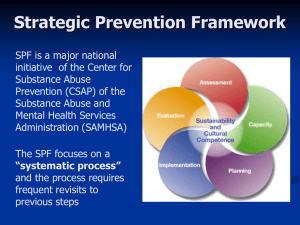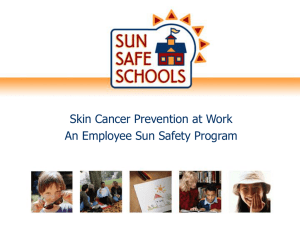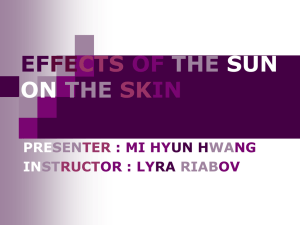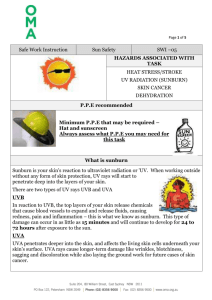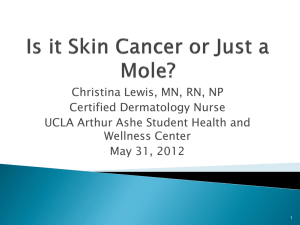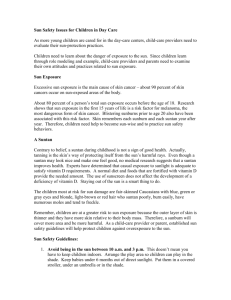Sunscreen factsheet
advertisement
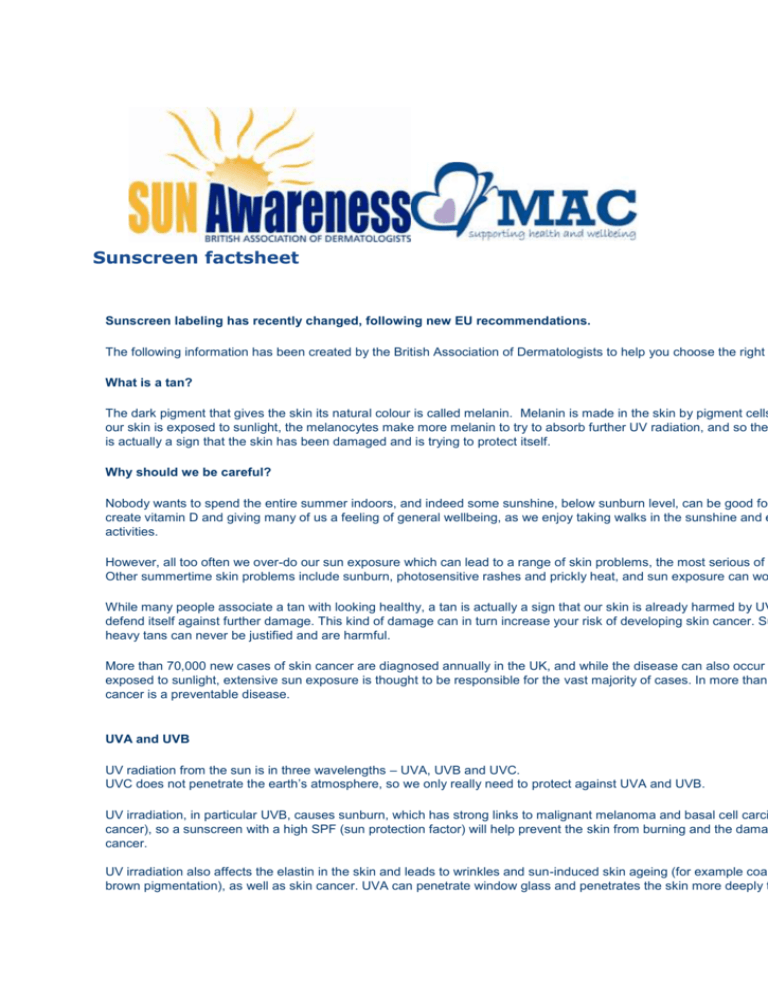
Sunscreen factsheet Sunscreen labeling has recently changed, following new EU recommendations. The following information has been created by the British Association of Dermatologists to help you choose the right What is a tan? The dark pigment that gives the skin its natural colour is called melanin. Melanin is made in the skin by pigment cells our skin is exposed to sunlight, the melanocytes make more melanin to try to absorb further UV radiation, and so the is actually a sign that the skin has been damaged and is trying to protect itself. Why should we be careful? Nobody wants to spend the entire summer indoors, and indeed some sunshine, below sunburn level, can be good fo create vitamin D and giving many of us a feeling of general wellbeing, as we enjoy taking walks in the sunshine and e activities. However, all too often we over-do our sun exposure which can lead to a range of skin problems, the most serious of Other summertime skin problems include sunburn, photosensitive rashes and prickly heat, and sun exposure can wo While many people associate a tan with looking healthy, a tan is actually a sign that our skin is already harmed by UV defend itself against further damage. This kind of damage can in turn increase your risk of developing skin cancer. Su heavy tans can never be justified and are harmful. More than 70,000 new cases of skin cancer are diagnosed annually in the UK, and while the disease can also occur exposed to sunlight, extensive sun exposure is thought to be responsible for the vast majority of cases. In more than cancer is a preventable disease. UVA and UVB UV radiation from the sun is in three wavelengths – UVA, UVB and UVC. UVC does not penetrate the earth’s atmosphere, so we only really need to protect against UVA and UVB. UV irradiation, in particular UVB, causes sunburn, which has strong links to malignant melanoma and basal cell carci cancer), so a sunscreen with a high SPF (sun protection factor) will help prevent the skin from burning and the dama cancer. UV irradiation also affects the elastin in the skin and leads to wrinkles and sun-induced skin ageing (for example coar brown pigmentation), as well as skin cancer. UVA can penetrate window glass and penetrates the skin more deeply t sunscreen will help defend the skin against photo ageing and potentially skin cancer also. How do sunscreens work? Organic filters absorb harmful UV radiation and convert and give this energy back out as infrared. These are sometim ‘chemical’ sunscreens. Note that organic filters does not mean ‘organic’ in the environmental sense. Inorganic filters (also known as ‘physical’, ‘natural’, ‘reflective’, ‘zinc’) contain titanium dioxide or zinc oxide, which ref the skin. It can be helpful to think of organic filters as sponges, mopping up the UV radiation, and inorganic filters as mirrors, b the skin. What is SPF? Sunscreens in the UK are labelled with an ‘SPF’. This stands for ‘sun protection factor’, although the SPF is more accurately the sun burn protection factor, as it primarily shows the level of protection against UVB, not the pr UVA star system When you currently buy sunscreen containing UVA protection in the UK, you may notice a UVA star rating on the pac 0 to 5 and indicate the percentage of UVA radiation absorbed by the sunscreen in comparison to UVB, in other words of protection afforded by the UVB protection and the UVA protection. Be aware that if you opt for a low SPF, it may have a high level of stars, not because it is providing lots of UVA protec between the UVA and UVB protection is about the same. That’s why it’s important to choose a high SPF as well as a high UVA protection (e.g. high number of stars). Sunscre UVB protection are sometimes called ‘broad spectrum’. New sunscreen labelling The new EU Recommendation means that you will notice changes on the labelling of some manufacturers’ sunscree number, the SPFs will be categorised as providing low to very high protection, to make the SPF guide easier to unde illustrates this: New Label SPF Low protection 6 to 14 Medium protection 15 to 29 (i.e. SPF 15, 20 and 25) High protection 30 to 50 (i.e. SPF 30 and 50) Very high protection 50 + (i.e. SPF 6 and 10) (i.e. SPF 50+) According to the EU Recommendation, the UVA protection for each sunscreen should be at least a third of the labelle achieves this requirement will be labelled with a UVA logo, the letters “UVA” printed in a circle: ‘Photostability’ means that the filters do not break down in the sun. What about SPF in moisturisers? SPF used in moisturisers are tested the same way as sunscreens, so an SPF 15 moisturiser should provide an SPF formulas are less likely to be rub-resistant and water resistant, and most importantly are likely to be applied a lot mor therefore are unlikely to offer the same level of protection. A moisturiser with an SPF will help protect you against small amounts of UV exposure, such as when you walk to the out the washing, but sunscreen is better suited for longer, more deliberate UV exposure, such as spending your lunc It is also worth noting that moisturizers containing an SPF may not contain any UVA protection. How should I apply sunscreen? Several factors affect the efficacy of sunscreens. One of these is the amount of sunscreen applied. Studies have foun less than half of the amount required to provide the level of protection indicated on the packaging. Studies also show and sides of the neck, temples and ears are commonly missed. Advances in the design of sunscreen products has led to the availability of a range of different formulas, including loti of this level of variation, it is not possible to give a set amount that you should apply, that is relevant to all products. In provide further details specific to the application of their particular sunscreens. When using lotions, as the bare minim least six full teaspoons (approximately 36 grams) to cover the body of an average adult. This is the amount used whe their SPF (it equates to 2 mg /cm²). Applying less will reduce the protection to a higher degree than is proportionate – half the required amount can actually reduce the protection by as much as two-thirds. The overall message in terms of sunscreen use is “more is better.” It is also easy to forget to reapply sunscreen as often as necessary. Apply sunscreen 15 to 30 minutes before going out in the sun to allow it to dry, and then again shortly after heading o patches and to make sure you’re wearing a sufficient layer. Reapply it at least every 2 to 3 hours, and straight after s drying or if you think it has rubbed off. Water resistance is defined as the ability of a sunscreen to retain its sun protection properties following two 20 minute of moderate activity in water. However, up to 85 percent of a product can be removed by towel drying, so you should sweating, or any other rigorous or abrasive activity. We recommend using a high protection SPF 30+, to take into account that most of us don’t apply sunscreen generou Vitamin D We know that UV light from the sun and sunbeds can increase risk of skin cancer. However, sunlight also helps the s vitamin D. A lack of vitamin D may cause health issues in some people. There is good evidence that vitamin D helps to keep bo suggested that vitamin D may help to prevent serious diseases such as cancer, various forms of arthritis and autoimm area of considerable research, as there are a large number of questions that still need to be answered, including whe made from sunlight on our skin to reduce the risk of getting these diseases. On the other hand the link between skin and well documented. We recognize that it can be hard to get the required level of vitamin D from the diet alone, which is why we do not say altogether. Unfortunately, we can’t give a precise level of sun exposure that will safely provide you with vitamin D, while also not cancer. This is because there are so many variables – for example, your personal skin type, the geographical locatio conditions and more. It is therefore difficult to quantify how much sun it takes to damage the skin, how much sun it takes for each individua of vitamin D, or furthermore to combine the two and define a safe level of sun exposure that allows each person to ge vitamin D without suffering skin damage. We do know, however, that once your body has produced its maximum leve does not increase production and will result in skin damage. Dermatologists are at the forefront of treating skin cancer, and therefore cannot recommend deliberate sun exposure vitamin D. A few points to consider are that: 1. You can get vitamin D from other sources, such as your diet and supplements 2. It is a fact that UV light from the sun causes skin cancer 3. Much of the evidence regarding health benefits of high levels of vitamin D require much more research to define w and how best to achieve these levels. We therefore currently advise that you should not sunbathe to increase your vitamin D levels as you may increase yo so. Small amounts of incidental sunlight, as you might get through your daily activities, may help to boost your vitamin face and forearms to the sun should be enough. However, if you are at high risk of skin cancer, you should make protecting your skin in the sun a priority, and look to possible from other sources, such as your diet and supplements, rather than placing yourself at higher risk from skin include: • people with very fair skin that easily burns • people with a personal or family history of skin cancer • people with lots of moles (more than 50) or • if you are being treated with immunosuppressive drugs. Much research is being done by dermatologists and other doctors in this area and into the role of vitamin D in diseas advice is to get some sunshine as you go about your daily life without getting a heavy tan or burning, and to get vitam foods are fortified with vitamin D (for example some yoghurts, margarine and cereals) and others, such as oily fish, a You can also take a vitamin supplement containing vitamin D, such as a multivitamin or cod liver oil, available from a Remember that your skin will produce plenty of vitamin D long before it starts to burn. For more information about vitamin D, click here. Skin types Naturally occurring biological agents in the skin absorb a proportion of UV irradiation, melanin being one of these. Me in the skin and is packaged slightly differently in people of different ethnic backgrounds. Dermatologists generally divide skin types into six categories, from phototype 1 - fair skin that burns very easily in the phototype 6, which is darker black skin that does not burn easily. People with a darker complexion have more natural sun protection, and fair-skinned individuals are more susceptible photodamage. See our leaflet on ‘Know your skin type’ for more information. The key character difference between black and white skin is that of melanin packaging and processing. The type of eumelanin except for those with red hair and freckles, who have phaeomelanin, which is less well able to cope with U If you tan very easily, as with black or Asian skin (e.g. types 5 and 6) you need less ultraviolet damage to initiate the need a sunscreen to stop skin cancer and skin ageing to the same extent as a fair skinned person, but sunscreen wil intense or prolonged exposure. If you are of Mediterranean type skin (e.g. Type 4), you also tan easily, but you will need more ultraviolet to tan than d suffer from UV damage and although you are less likely to develop melanoma than skin types 1 to 3, your skin will ag If you are very fair and cannot tan at all (e.g. Type 1), you will not tan with or without a sunscreen, but you will damag without protection. You need to take particular care to regularly apply lots of high SPF sunscreen (i.e. 30 or above) w Recommendations regarding sun protection (e.g. clothing, shade and sunscreen) should be used in conjunction with example, the use of clothing and sunscreen applies to skin types I and II at all times in the sun, and to skin types V a prolonged or intense sun exposure. Darker skin types do not need to routinely use sunscreens. Will I still tan through sunscreen? You may tan (even if you don't want to) through a low to medium SPF sunscreen due to the tiny amount of ultraviolet you very carefully and regularly apply lots of high SPF sunscreen with high UVA protection too. If no ultraviolet gets th therefore no tanning can occur. Top sun safety tips • Protect the skin with clothing, including a hat, T shirt and sunglasses • Seek shade between 11am and 3pm when it’s sunny • Use a ‘high protection’ sunscreen of at least SPF 30 which also has high UVA protection, and make sure you apply when in the sun. • Keep babies and young children out of direct sunlight • The British Association of Dermatologists recommends that you tell your doctor about any changes to a mole – if yo your skin, make sure you see a Consultant Dermatologist (on the GMC register of specialists), the most expert perso Your GP can refer you via the NHS. Sunscreens should not be used as an alternative to clothing and shade, rather they offer additional protection. The British Association of Dermatologists supports the British Skin Foundation Skin Cancer Appeal, raising vital fund cancer. © British Association of Dermatologists 2009
